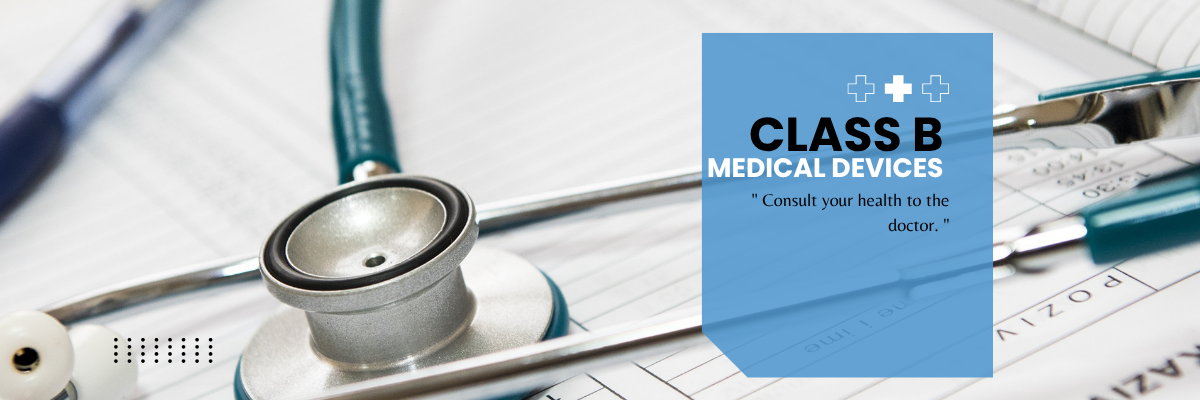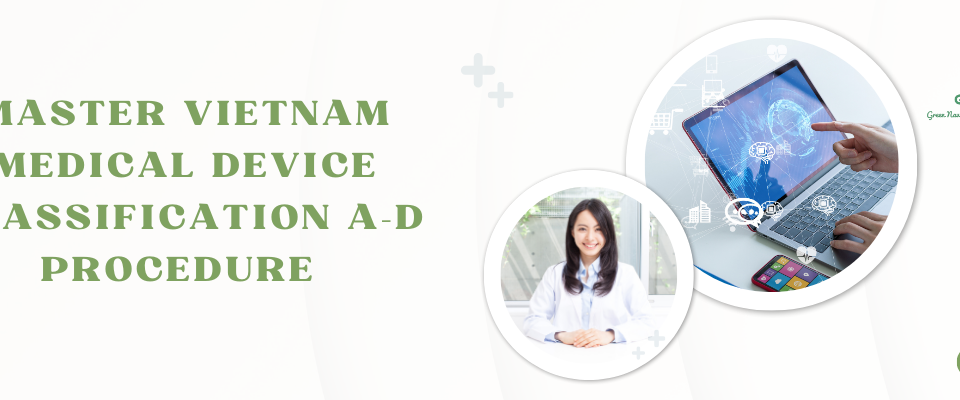- If you have any questions, please contact us!
- +84 965 624 065
- info@greennrj.com.vn
Class B Medical Devices: Simplified Import Procedures into Vietnam (2025)

Class A Medical Devices: Simplified Import Procedures into Vietnam (2025)
June 26, 2025
How to Successfully Import Class C and D Medical Devices into Vietnam (2025 Complete Guide)
July 7, 2025If you’re planning to import Class B medical devices into Vietnam in 2025, it’s essential to know upfront: this isn’t just a matter of shipping and customs. Vietnam has tightened its rules, especially after Decree 98/2021/ND-CP (amended by Decree 07/2023/ND-CP), and without the proper classification, declaration leading to a declaration of applicable standards, and trading licenses, your goods may sit at customs—or worse, be turned away. Here’s what you need to know, in plain terms.
Why This Matters Now
Vietnam’s medical device market is growing quickly. But so are the regulations. Even if your product seems simple—say, a digital thermometer or a blood pressure cuff—it may fall under Class B and require formal declaration. Many importers assume only Class C or D devices are heavily regulated, but that’s no longer the case.
Understanding the new 2025 import procedures early can save you from expensive delays later.
Class B Medical Device Classification in Vietnam
What qualifies as a Class B device?
Class B medical devices are considered low-to-medium risk products that interact with the human body but are generally non-invasive or short-term. Examples include:
-
Blood pressure monitors
-
Nebulizers
-
Dental tools
-
Surgical gloves
-
Infusion sets
Who performs the classification?
Under Vietnam’s current medical device regulations (Decree No. 98/2021/ND-CP), the importing or distributing entity (the registration holder) is responsible for self-classifying the medical device as part of their application dossier. This ensures accountability and streamlines the process.
That said, the classification must still follow the criteria outlined in Appendix I of Circular 05/2022/TT-BYT. Importers should ensure the classification is well-documented and consistent with international standards to avoid rejection or delays during the declaration process.
Note: If you’re uncertain or lack in-house regulatory expertise, it’s still advisable to consult a local regulatory service provider for review and verification.
How to Declare Class B Medical Devices in Vietnam
Declaring a Class B medical device in Vietnam to complete the Declaration of applicable standards is a crucial and mandatory step before you’re allowed to import it legally. This isn’t just a formality—it’s a formal registration process required under Decree No. 98/2021/ND-CP. If the application is submitted incorrectly, it can result in significant customs delays, inspection failures, or administrative penalties.
Step 1: Prepare documents for declaration Submission
Getting the paperwork right from the start will save you a lot of back-and-forth later. You’ll need to prepare a dossier that includes:
-
A completed Application Form for Declaration of applicable standards (as prescribed in Circular 05/2022/TT-BYT)
-
Classification result (confirming Class B)
-
ISO 13485 certificate of the manufacturer
-
Letter of authorization (or Power of Attorney) issued by the Manufacturer or the Brand Owner, assigning rights to the importer or authorized representative in Vietnam
-
Confirm warranty eligibility or confirm product is not under warranty
-
User manual
- Product label
Important Note for Foreign Documents: All documents issued by foreign entities, such as the Certificate of Free Sale (CFS) and the Letter of Authorization, must be legalized/apostilled by the Vietnamese diplomatic mission (embassy or consulate) in the country of origin and officially translated into Vietnamese by a qualified translation service. This is a critical step for legal validity.
Step 2: Submit online via DMEC Portal
All declaration applications are submitted through the Ministry of Health’s Public Service Portal at: https://dichvucong.moh.gov.vn/
Once the application is approved, the system issues a unique declaration of applicable standards. This number is mandatory for customs clearance and legal distribution of the Class B medical device in Vietnam.
Customs Clearance for Class B Devices
After obtaining the Declaration of applicable standards, importers can proceed with customs clearance. For Class B medical devices, this number effectively serves as the import permission, eliminating the need for a separate import license. All submitted documents must be accurate and consistent, as the Ministry of Health may conduct post-market inspections; thus, all records must be retained and ready for review.
Here’s what your import dossier should include:
| No. | Document | Description |
|---|---|---|
| 1 | Commercial Invoice | Lists the value and description of goods; must match packing list and shipping docs. |
| 2 | Bill of Lading / Airway Bill | Transport document proving ownership and shipment details. |
| 3 | Certificate of Origin (C/O) (if applicable) | Required if claiming preferential tax rates under trade agreements. |
| 4 | Packing List | Itemizes all products in the shipment, quantity, and packaging details. |
| 5 | Customs–Business Partnership Agreement (optional, region-specific) | Some customs branches may ask for this partnership agreement to streamline clearance. |
| 6 | Classification Result | Confirms the device is classified as Class B under Circular 05/2022/TT-BYT. |
| 7 | Declaration of applied standards receipt | The unique number issued by the Ministry of Health system after successful approval of the Declaration of applicable standards. This replaces the traditional import license. |
Product Labelling Requirements
All Class B medical devices imported into Vietnam must comply with local labelling regulations. If the original label does not contain all required information in Vietnamese, a secondary label in Vietnamese must be affixed. This label should include:
- Product name and model
- Manufacturer and origin country
- Importer’s information
- Instructions for use and any warnings
This is mandated under Decree 43/2017/ND-CP and Circular 05/2022/TT-BYT. Improper labelling can result in customs holds or fines during post-market inspection.
Legal Requirements to Trade Class B Medical Devices in Vietnam
Importing a Class B medical device is only one part of the process. If your company wants to sell and distribute Class B devices in Vietnam, you are legally required to obtain a Certificate of Eligibility for Trading in Medical Devices. This is not optional. Even if your products are fully registered and cleared through customs, you cannot legally put them on the market without this certificate—especially for Class B, C, and D devices.
To apply for the certificate, your company must meet several conditions, as set out in Decree 98/2021/ND-CP:
| Requirement | Details |
|---|---|
| Valid business registration | Your enterprise must be legally established in Vietnam and have medical device trading listed in its registered business lines. |
| Qualified personnel | At least one full-time employee must hold a university degree or higher in medicine, pharmacy, medical equipment, biomedical engineering, or similar. This person is responsible for technical oversight. |
| Suitable warehouse or storage facility | You must have a physical location that meets storage requirements for medical devices—clean, dry, pest-controlled, with appropriate temperature/humidity control where needed. Shared or rented warehouses may be accepted if properly documented. |
| Internal procedures | Your business must have documented procedures for quality control, product recall, warranty handling, and complaint resolution. These don’t need to be complex, but they must be real and auditable. |
Additional Information for Foreign Businesses
Do I need a local partner?
Yes. Only Vietnamese legal entities can submit declarations and import medical devices. Foreign manufacturers must appoint:
-
A Vietnamese Authorized Representative, or
-
Work through a licensed importer/distributor
Can I use one Declaration of applicable standards for multiple importers?
No. Each Declaration of applicable standards is specific to one legal entity. If multiple importers distribute the same device, each must obtain their own Declaration of applicable standards through the declaration process.
Once issued, the Declaration of applicable standards remains valid indefinitely, unless there is a change in product classification, specification, or intended use
What qualifications are required to trade Class B medical devices in Vietnam?
To trade Class B medical devices in Vietnam, your company must have:
- A valid business registration with medical device trading listed
- At least one full-time employee with a relevant medical or technical degree
- A compliant warehouse for storage
- Documented quality management procedures
These are required under Decree 98/2021/ND-CP.
How long does it take to import Class B medical devices into Vietnam?
If all documentation is accurate and complete, importing Class B medical devices into Vietnam can take anywhere from 2 to 4 weeks, including the declaration process and customs clearance. Delays often happen due to errors in classification or missing paperwork
What happens if my Class B medical devices are misclassified?
Incorrect classification of Class B medical devices in Vietnam can result in declaration rejection, customs delays, or penalties during post-market inspection. That’s why it’s important to follow the Ministry of Health’s guidelines and seek expert review when needed.
Is the declaration process for Class B medical devices considered a formal product registration?
Yes. The declaration process for Class B medical devices leads to the issuance of a Declaration of applicable standards, which is considered the formal product registration required under Decree No. 98/2021/ND-CP (as amended by Decree No. 07/2023/ND-CP). It is a mandatory step before customs clearance and legal distribution.
Conclusion: Import Class B Medical Devices Smoothly in Vietnam (2025)
Successfully importing Class B medical devices into Vietnam in 2025 isn’t just about getting through customs—it requires proper classification, successful declaration leading to a Declaration of applicable standards, and a trading license that meets Ministry of Health requirements.
By understanding and following these steps carefully, you’ll minimize delays, stay compliant, and enter Vietnam’s growing medical market with confidence.
👉 Need expert help?
Contact Green NRJ today, let us assist you with product classification, MOH registration, and setting up your legal presence in Vietnam.


